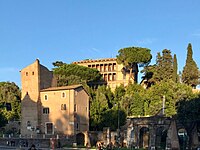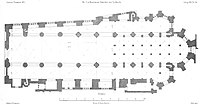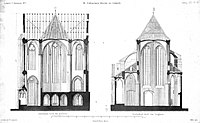Paul Laspeyres
Paul Laspeyres (born April 22, 1840 in Halle , † May 14, 1881 in Rome ) was a German architect and architectural historian .
Life
Laspeyres was the descendant of a Huguenot family that originally came from southern France and had been based in Berlin since the 17th century . His father was the legal scholar Ernst Adolf Theodor Laspeyres and his brothers the mineralogist Ernst Adolf Hugo Laspeyres and the economist and statistician Étienne Laspeyres .
He grew up first in Erlangen and then from 1846 in Lübeck , where his father was appointed as a judge at the Higher Appeal Court of the four Free Cities . After visiting the Katharineum in Lübeck , he began his architectural studies in 1859 as a trainee with the city architect Paul Richard Thomann (1827–1873) in Bonn . From 1860 he studied at the Berlin Building Academy and passed his master builder examination here in 1869 . As early as 1868 he entered the Schinkel competition of the Berlin Architects' Association with distinction .
He moved to the south of Europe to alleviate his lung disease and stayed in Rome for the rest of his life. Here he was a “loyal consultant” to young architects who moved to Rome, supervised the restoration and renovation work in Palazzo Caffarelli , the seat of the Prussian legation and later embassy of the German Empire, and it was here that he created the building from 1872 to 1877 of the German Archaeological Institute, the only larger building that was built according to his designs.
Soon he shifted the focus of his activity to the study and recording as well as the publication of older architectural monuments in Italy. In 1868, after his first stay in Italy (1865–1867), he published the church of Santa Maria della Consolazione in Todi, which was at the time attributed to Donato Bramante , and other buildings in this city in the Bauwesen magazine ; In 1871 he published his older recording of the Katharinenkirche in Lübeck here .
In 1872 he began a larger publication on the monuments of Umbria , which was only continued shortly before his death. In the last years of his life, Laspeyres worked with the support of the Prussian Ministry of Culture on the publication of a work on the Renaissance churches in Italy, of which the first volume was already available in test prints at his death, while for the remaining volumes there were partly ready-to-print drawings and partly sketches.
Laspeyres died in Rome and was buried in the Protestant cemetery , where his grave has been preserved to this day.
Fonts
- S. Maria della consolazione at Todi. In addition to communications about the medieval architectural monuments of this city, four copper plates and twenty woodcuts printed in the text. Ernst & Korn, Berlin 1869.
- The buildings of the Renaissance in Umbria. 2 volumes, Ernst & Korn, Berlin 1873 (volume 1, digital-sammlungen.de ) and 1883 (volume 2, archive.org ).
- The churches of the Renaissance in central Italy. (with the support of the Royal Prussian Ministry for clergy, teaching and medicinal matters edited by H. Angelroth) W. Spemann, Stuttgart 1882.
literature
- Laspeyres, Paul . In: Hans Vollmer (Hrsg.): General lexicon of fine artists from antiquity to the present . Founded by Ulrich Thieme and Felix Becker . tape 22 : Krügner – Leitch . EA Seemann, Leipzig 1928, p. 408 .
- Paul Laspeyres. In: Deutsche Bauzeitung . 15th year 1881, No. 41 (from May 21, 1881), pp. 243–244 (obituary under the heading “Miscellaneous”, Textarchiv - Internet Archive ).
Web links
Individual evidence
- ↑ a b Paul Laspeyres. In: Deutsche Bauzeitung . 1881, p. 243 ( Textarchiv - Internet Archive ).
- ↑ The St. Catharine Church in Lübeck. In: Zeitschrift für das Bauwesen , Volume 21, 1871, Sp. 357–364. ( Digitized version of the booklet); the elevations in the 1871 atlas , pages 54–58 ( digitized version ; PDF; 35.5 MB).
- ↑ Grave No. 2339, gravestone S1818
| personal data | |
|---|---|
| SURNAME | Laspeyres, Paul |
| BRIEF DESCRIPTION | German architect and architectural historian |
| DATE OF BIRTH | April 22, 1840 |
| PLACE OF BIRTH | Halle (Saale) |
| DATE OF DEATH | May 14, 1881 |
| Place of death | Rome |








